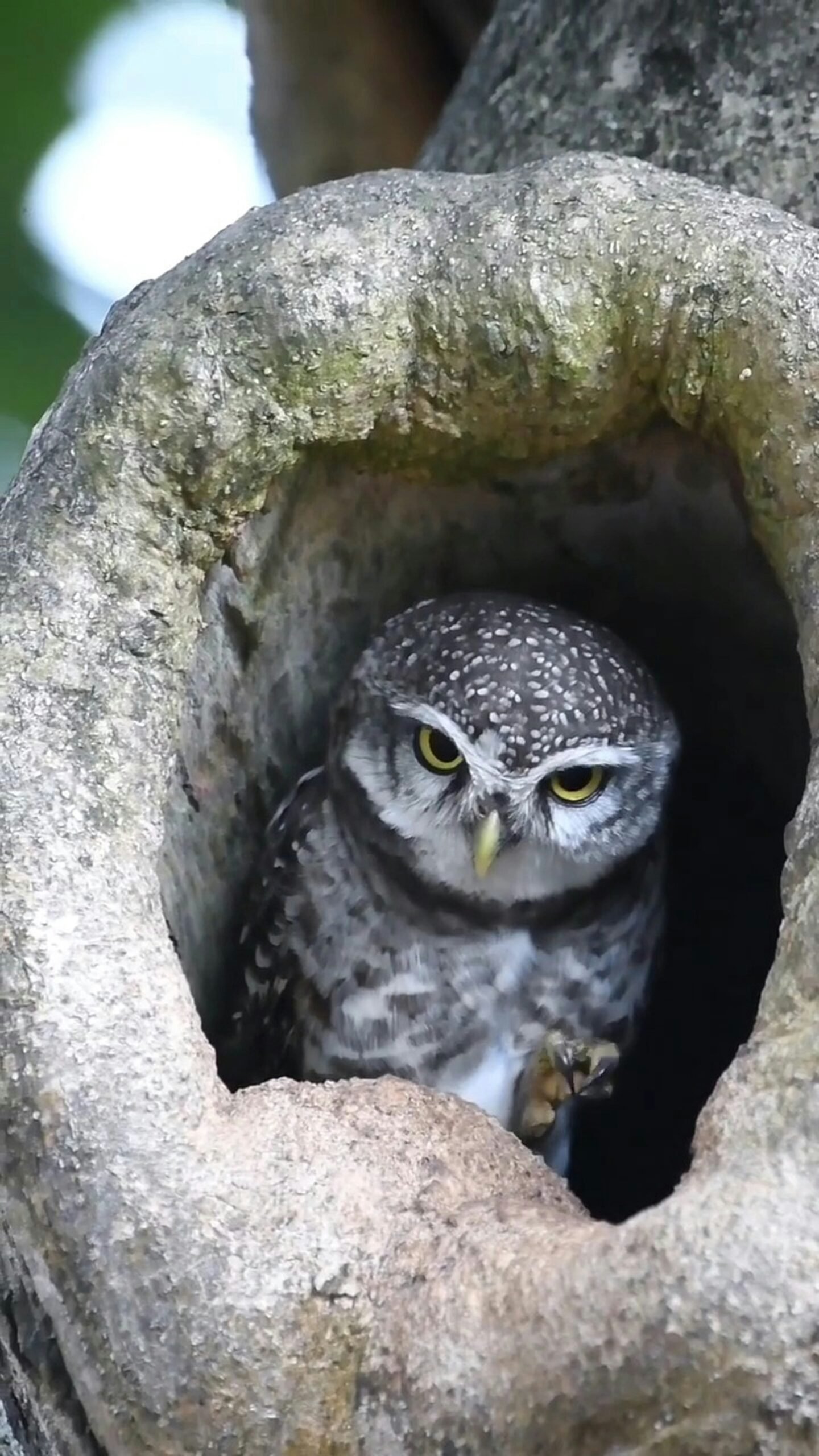Unique Physical Features
Owls, as nocturnal birds of prey, possess several distinctive physical characteristics that differentiate them from other avian species. One of the most notable features is their large, round heads, which house forward-facing eyes. This unique arrangement grants owls exceptional binocular vision, allowing them to judge distances accurately when hunting in low-light conditions. Unlike many other birds, owls do not have the ability to move their eyes; instead, they can rotate their heads approximately 270 degrees, providing them a wider field of view without the necessity of moving their bodies.
The structure of an owl’s feathers is another fascinating aspect contributing to their effectiveness as hunters. Unlike typical bird feathers, owls have specialized fringed leading edges on their primary feathers, which help reduce turbulence during flight. This adaptation enables them to fly almost silently, an essential trait for stalking their prey unnoticed. The soft edges of their feathers break up the sound of the wind passing over them, facilitating a stealthy approach that is critical in the predatory lifestyle of owls.
Furthermore, the powerful talons of these birds are designed for catching and gripping their prey with lethal efficiency. The sharp claws enable them to capture and hold on to live animals, which serves as a vital adaptation in various habitats, from forests to grasslands. These physical features collectively play a significant role not only in their hunting prowess but also in their survival. With their unique morphology, owls have become exceptionally well-adapted to their ecological niches, showcasing the diverse evolutionary paths that avian species can take.
Varied Species and Habitats
Owls, with over 200 distinct species, exhibit an impressive diversity that allows them to thrive in various environments across the globe. Their adaptability is evident not only in their physical characteristics but also in their behaviors and dietary preferences. Among the most well-known species are the Great Horned Owl, the Barn Owl, and the Snowy Owl, each demonstrating unique ecological adaptations that enable them to occupy diverse habitats.
The Great Horned Owl, recognizable by its tufted ears and fierce yellow eyes, can be found throughout the Americas in a range of landscapes including dense forests, open fields, and urban areas. Its versatile diet primarily consists of small mammals, which it easily captures with its powerful talons. These owls are known for their adaptability, allowing them to thrive in regions heavily modified by human activities.
In contrast, the Barn Owl is distinguished by its heart-shaped face and exceptional hunting abilities, primarily adapted for hunting in low-light conditions. This species prefers habitats such as agricultural fields and grasslands, where it primarily preys on rodents. The Barn Owl’s remarkable auditory capabilities enable it to locate prey even in complete darkness, showcasing the owl’s specialized evolutionary traits.
The Snowy Owl, often associated with the Arctic tundra, features pure white plumage that provides excellent camouflage against the snowy landscape. These owls primarily hunt for lemmings and other small mammals, demonstrating a focus on cold-resistant prey. During migration, they can find themselves in varied environments, from coastal areas to grasslands, showcasing their flexibility in habitat selection.
Owls have adapted to a multitude of ecological niches, which can be attributed to their nocturnal nature and diverse diets. Their geographical distribution across continents illustrates how these fascinating birds have successfully evolved to meet the demands of various ecological conditions. Understanding this diversity is crucial for fostering appreciation and conservation efforts for owls worldwide.
Fascinating Hunting Techniques
Owls are remarkable predators, distinguished by their advanced hunting techniques, which enable them to thrive in various environments. One of the most notable aspects of their hunting prowess is their exceptional hearing. Owls possess asymmetrical ear placements, allowing them to pinpoint the exact location of sounds, even in complete darkness. This auditory precision is crucial for detecting the faintest noises made by potential prey, such as small mammals scurrying through the underbrush.
In addition to their remarkable hearing, owls are equipped with remarkable eyesight. Their large, forward-facing eyes are adapted for night vision, enabling them to see in low-light conditions where other animals may struggle. The unique structure of their eyes provides a wide field of view, enhancing their ability to spot unsuspecting prey, which often includes rodents, insects, and even other birds. This combination of acute senses allows owls to locate food sources with remarkable accuracy.
The hunting styles employed by these birds of prey vary significantly. Some owls, such as the Great Horned Owl, actively hunt by flying through their territory to seize unsuspecting targets. Others, like the Barn Owl, may adopt a more ambush-style approach, perching quietly and waiting for the right moment to pounce on their prey. This adaptability enables different owl species to thrive in diverse habitats, from dense forests to open fields.
Case studies of specific owl species reveal fascinating insights into their hunting strategies. For instance, the Eastern Screech Owl primarily hunts small insects and rodents, utilizing its camouflaged plumage to remain undetected until it strikes. Conversely, the Burrowing Owl employs a unique behavior of nesting in abandoned burrows, allowing it to exploit a range of prey while maintaining a low profile. Through these varied hunting techniques, owls demonstrate their resilience and skill as adaptable hunters in an ever-changing environment.
Cultural Significance and Myths
Owls have long captivated human imagination, appearing in various cultural narratives and symbols across different societies. Their nocturnal nature and unique physical characteristics have led them to be ascribed both wisdom and foreboding. In many cultures, owls are seen as wise creatures, often associated with knowledge and intellect. This perspective is prominently displayed in ancient Greek mythology, where Athena, the goddess of wisdom, is frequently depicted with an owl as her companion. This connection has contributed to the owl’s reputation as a symbol of wisdom in Western cultures.
Conversely, owls have also been viewed with suspicion and fear. In some Native American traditions and European folklore, these birds are considered omens of death or misfortune. The belief in owls as harbingers of doom has led to a complex relationship with these avian creatures, where they are both revered and feared. This duality is exemplified in numerous stories and legends where owls serve as messengers between the living and the dead, highlighting their role in navigating the mysteries of life and death.
Moreover, owls have made significant appearances in literature and art. Renowned works, such as those by Edgar Allan Poe and Aesop’s Fables, feature these birds prominently, contributing to their air of mystery and otherworldliness. In contemporary culture, owls have also found their place in conservation efforts as symbolic advocates for wildlife preservation. Various organizations use the owl as a mascot to promote awareness of environmental issues and the importance of protecting natural habitats. By examining the layered representations of owls in different cultures, one gains a deeper understanding of how these fascinating creatures have shaped human narratives and the vital role they play in ecosystems worldwide.


Leave a Reply